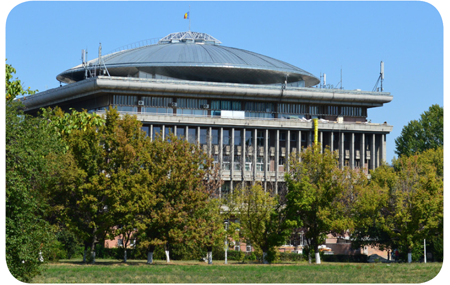Venue
Ways to get to the Symposium
All conference activities (welcome party, sessions, lunches, dinner) will be held in the
Library of the University Politehnica of Bucharest (www.library.pub.ro).
Please click HERE or scan the QR code

to get the location, or look at the below map.
|
 |
-
From the Bucharest Henri Coanda International Airport to the Library of the University Politehnica of Bucharest (the conference venue):
- By cab. Please, use only authorized cabs!
- By expres line 783 to Piata Unirii Station, the last stop (Airport stops are in front of the Arrivals Terminal and Departures Terminal; price for one trip is 3.5 lei, the magnetic card valid for two travels costs 7 lei; card desk in front of the Arrivals Terminal). Then:
a) by subway from Piata Unirii Station, line M1 (yellow line), direction Dristor, to Grozavesti Station – subway map, and have a walk for 10-12 minutes to the Library of the University Politehnica of Bucharest (“Biblioteca Centrala”) – MapGrozavestiSubway-Library.
b) by subway from Piata Unirii Station, line M3 (red line), direction Preciziei, to Politehnica Station – subway map, and have a walk for 10-12 minutes to the Library of the University Politehnica of Bucharest (“Biblioteca Centrala”) – MapPoliSubway-Library.
-
From the Bucharest International Railway Station of Bucharest North (Gara de Nord) to Library of the University Politehnica of Bucharest (the conference venue):
- By cab. Please, use only authorized cabs!
- By subway from Gara de Nord Station, line M1 (yellow line), direction Republica, to Grozavesti station –subway map, and have a walk for 10-12 minutes to the Library of the University Politehnica of Bucharest (“Biblioteca Centrala”) –MapGrozavestiSubway-Library.
- By bus 105 to “Podul Grozavesti” Station – 4 stops (there is a card desk in the bus station), and have a walk for 10-12 minutes to the Library of the University Politehnica of Bucharest (“Biblioteca Centrala”) –MapGrozavestiSubway-Library.
- By trolley bus 62 to “Vasile Milea” Station (University Politehnica of Bucharest) - 5 stops (there is a card desk in the trolley bus station), and have a walk for 10-12 minutes to the Library of the University Politehnica of Bucharest (“Biblioteca Centrala”) –MapPoliSubway-Library.
Romania is one of the largest countries of Europe (the size of the United Kingdom or roughly half of France), with a population of approx. 22 million inhabitants. Along with the Romanians, Hungarians, Germans, Serbs, Turks and other minorities also live in the country. Most of them are of Greek-Orthodox religion, but there are also many Catholics, Protestants, Evangelical, Muslims and others.Often compared to a “Latin island in a Slav sea”, Romania features a unique familiar feeling in Eastern Europe: its language of a Latin origin, the Latin alphabet (quite rare in this part of Europe) and moreover the Latin temperament and friendliness of its people – all make of Romania a place where most visitor feel very comfortable.
Bucharest is Romania’s capital and largest city, as well the main political, administrative, economic, financial, banking, educational, scientific and cultural center of the country. With more than 2.4 millioninhabitants in the urban area, Bucharest is one of the largest cities in Southeastern Europe.
Legend says that Bucharest was founded by a shepherd named Bucur (bucurie; literally ‘joy’) who built a church on the right bank of the Dâmboviţa River.
The city, which lies on the Wallachian plains between the Carpathian foothills and the Danube River, was settled by Geto-Dacians as early as 70 BC. By 1459 a princely residence and military citadel had been established under the chancellery of Prince Vlad Ţepeş. By the end of the 17th century, the city was the capital of Wallachia and ranked among southeastern Europe’s wealthiest cities. Bucharest became the capital of the Romania kingdom in 1862.
The early 20th century was Bucharest’s golden age. Large neoclassical buildings sprang up, fashionable parks were laid out and landscaped on Parisian models and, by the end of the 1930s, Bucharest was known throughout Europe as ‘Little Paris’. Although many areas of Bucharest were demolished in the Communist period, to make way for the standard districts that had the same architecture, it still retains the old charm. Bucharest has benefited from an economic boom along with the EU grants that have helped rebuild neglected parts of the city, such as the historic Lipscani area.
Today the city is a mix of old and new, a mix of traditional and modern, East and West, which gives the appearance of an eclectic city.
University “POLITEHNICA” of Bucharest (UPB) is the largest and the oldest technical university in the country and among the most prestigious universities in Romania. The tradition of our institution, developed in over 195 years through the effort of the most important nation’s schoolmasters and of the generations of students, is not the only convincing reason. Today, the UPB is undergoing a continuous modernization process, being involved in a permanent dialogue with great universities in Europe and all over the world. |
 |
The mission of UPB has been thought over as a blend of education, research and innovation, which represents a key towards a knowledge-based society and economy. Creating knowledge mainly by scientific research, giving it out by education and professional training, disseminating it by information technologies, as well as the use of technological innovation are elements that define the university distinctive profile. In order to face these complex challenges, the UPB is planning a sound educational and research-development policy with the participation of the entire community. |



